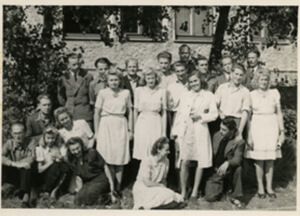 A group of Estonian students. Photos from the VEMU archive, Toronto, Canada, (Järvesoo archive)
A group of Estonian students. Photos from the VEMU archive, Toronto, Canada, (Järvesoo archive)
Tragedy, hope, success – all elements to build a great story were there and yet there had never been a film about the Baltic University. It was hard to believe.
The Baltic University had been such an unbelievable achievement: who could imagine that refugees who had lost everything would create a university so shortly after WW II, in an almost totally devastated city. The story should have been made available to a larger audience one way or another. But I found it was not. So I decided to make a documentary film about it: The story of the Baltic University.
The first idea for a university for refugees came from Professor Gulbis, who had worked as the deputy rector of the university of Riga. Already in the summer of 1945 he wanted to establish academic courses for Latvian students.
Professor Gulbis needed to have permission from the Military Administration in Hamburg. While in Hamburg he met representatives of the other two Baltic Countries, one of them being professor Öpik, and together they tried to seek consent to establish academic courses of study for all three nations – to create a Baltic University.
It seemed to be an impossible plan, as Hamburg was in large part destroyed and there was a shortage of everything: housing, coal, lightbulbs, desks, but also food, clothes…
Former student Maia Inari: we didn’t have paper in the beginning; there were no books. There was no possibility to buy anything, as there were no shops.
Nonetheless on the 14th of March 1946, only a couple of months after the academicians of the Baltic Countries were given permission to create a university and the Baltic University could open its doors. It consisted of 8 Faculties with 17 departments.
 Students and teachers of the Baltic University. Professor Öpik is front row, third from the right
Students and teachers of the Baltic University. Professor Öpik is front row, third from the right
The Baltic University supported the young people who had lost their home country, their families, who had lost their hope, so they could continue their interrupted academic education and achieve something in life later on, says Reinhold Martin, who studied at the Baltic University.
The Baltic University started with great promise, but soon the first problems began; not everyone wanted a university for students of the Baltic Countries.
The idea was still that people from the Baltic Countries could and should go home. The word Baltic could no longer be used.
This turned out to be the first in a long row of problems, but the academic leaders of the three Baltic Countries were acting, struggling and fighting together; sharing their food and income to find a way to keep the university open.
Reinhold Martin: We used to joke about our friendly `minder’ Mr. Riggle, who in one of his enthusiastic speeches called the Baltic University `mankind’s greatest achievement’, but in a sense he was right: it was unique.
When I learned about the Baltic University it became clear to me that this was a story we can still learn from. During the past years I gathered stories, books, pictures, documents and rare footage. I made this into a film: The story of the Baltic University, to pass on the story of this amazing institution to the next generation.
Helga Merits










